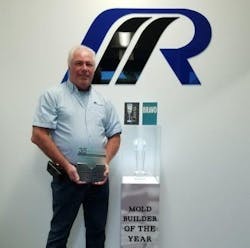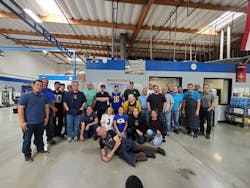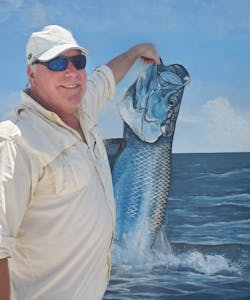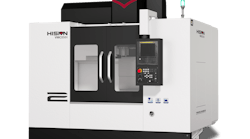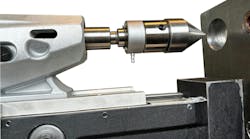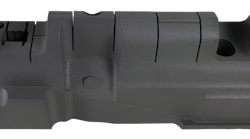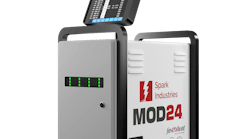By Karen Hanna
On the show “MacGyver,” it seemed the titular character could squeeze his way out of any predicament using only shoestrings, a wad of gum and birthday candles.
Of course, the action hero sometimes needed something a bit more complex, as M.R. Mold owner Rick Finnie can attest — in one episode, he saw a defibrillator keypad featured on the show — the mold for which came from Finnie's own shop. And just a few years ago, while in the hospital with an infection, Finnie noticed a device in the IV line in his arm was created from a mold his Brea, Calif., company made.
Since getting his start as an errand boy, Finnie has fashioned a career as a recognized leader in silicone mold making. He spoke recently with Plastics Machinery & Manufacturing Senior Reporter Karen Hanna.
How did you get your start in mold making?Finnie: My father was a tool and cutter grinder, back in the ’60s and ’70s. Back before we had computers, if you wanted a special shape in a piece of steel, you had to have a form tool that had that shape on it, and that's what my father did.
I first worked for my father back in my teen years. Then, his health was failing and he needed to close the business, so I ended up going to work for one of my father's customers, who was a mold maker.
I was still a senior in high school. I only had three classes, so I was at work by 11 o'clock in the morning. As the young, low person on the totem pole, my first task was to go around and take everybody's sandwich order.
I eventually worked my way up in the company, and then, with the encouragement of my father, in 1985, I left and started my own business.
I had been involved in silicone and liquid silicone from the beginning, when the materials first were introduced. Back in the ’90s, we found ourselves focusing more on the plastic injection industry than on the rubber industry. But around 2000, there was a mass exodus of manufacturing from the United States. So, I was searching for a niche in the industry, and silicone was a niche that we [had]. I have far fewer competitors in the silicone industry. In the plastics industry, there [are] thousands of mold builders. In the silicone business, maybe there [are] hundreds, so that was the reason why we focused on silicone.
Over the years, you’ve overseen a lot of molds. What designs stick out to you as particularly challenging or satisfying?
Finnie: Some of the parts that we've been working on recently are sleep apnea devices. It's a delicate balance between the comfort of the patient and makingWe've always been conscious of what the product is.
We're working on a mold for baby bottle nipples, so we know we need to be careful because this is going in the baby's mouth. And we've worked on a lot of reseal devices that go in an IV line, so we realize this is a fluid path right into the human body, so we're very careful about how the tool is built.
Many of the products [are] medical devices. There [are] even some little tiny masks for premature babies. Whenever a design comes across my desk and I see issues with that, I let the customer know, “Hey, I think there's something that could go wrong with your product here.”
Is there a special satisfaction you take from some of those medical devices?
Finnie: A couple of years ago, I found myself in the emergency room. I had an infection, and they put an IV line in my arm. I looked over at my arm and the IV line, and inside the IV line was a reseal device, a silicone valve that we built the mold for, and I took a picture of it. The nurse freaked out because she thought I thought she did something wrong. And I told her, “You didn't do anything wrong. IHow important is plastics to your business?
Finnie: We do probably about 80 percent silicone tools and 20 percent plastics tools.
In the respiratory care business, we’ve made a number of plastic injection tools. Years ago, we made tools for cell phones and keyboards. Once upon a time, Apple used to make products in the United States.
One of the key things that we’ve been doing lately is we do a lot of tools for overmolding silicone on the plastics, so we make the plastic tool and the silicone tool and then ensure they work together. Four of our six presses have plastic injection barrels, as well, for testing and sampling.
Where do you see that that interest in overmolding coming from?
Finnie: Almost exclusively medical parts. Well, that’s not completely true. I mean, it’s the electronics industry, the medical industry, the auto industry.
Silicone is frequently used as a seal. If you overmold the seal right onto the plastic, that eliminates an assembly operation and also makes for a better seal.
What are other trends are you seeing?
Finnie: People are pushing for more and more automation. The labor shortage is a major issue, and companies are trying to make up for it with automation. They have it much easier to automate plastics because the plastic components, [it] tends to be well-known where the part is going to be in the mold when the mold opens, and then you can provide for a mechanism to eject a part from the mold.
But silicone doesn’t behave quite as easily, and it’s a little harder to automate. But that’s definitely something that customers are pushing for.
There are companies who are trying to make the molding machines more sophisticated and the pumping units more sophisticated, and being able to produce data to the industry that the process is stable and reproducible. It’s one of the things the medical industry wants: proof that your process is stable, and that you’re making quality products.
Is expertise with plastics molding transferable to LSR molding, and vice versa?
Finnie: There are similarities. We use the same types of steel; we use the same components to assemble the mold that we would use in the plastics industry.
Some of the biggest differences is in the plastics industry, we’re water-cooling the mold, while in the silicone industry, we’re heating the mold, so it’s a big transition. Our molds still have runners and gates just like plastics tools; we just make them much smaller.
You’ve been teaching classes for several years now, starting with a workshop at the University of Wisconsin-Milwaukee. How did you get into that?
Finnie: Back around 2008 or 2009, I actually went to the class in Wisconsin. I ended up talking to the fellow [who] organizes and runs the course, and the following year, he invited me to be the instructor on tooling, and I’ve been doing it ever since. The instructors, we’re not credentialed teachers, we’re all just industry veterans.
We’ve actually spun off and created our own training class that we’re doing here in California [instead of Wisconsin], so we have that’s coming up [from Jan. 31 to Feb. 2 at Cal Poly Pomona, the week before MD&M West 2023]. There’s one day that we spend here at M.R. Mold.
Forty-five [students were] in the [last] class in April. We typically draw the line at about 50 students or so. We had a lot of fun. The other instructor, we’ve been lifelong friends. We’ve known each other for decades.
This last time, we had five molding machines set up to run various parts, and the students — we broke them into teams — moved from station to station to station.
We have a number of OEMs that come to the class because they want to learn more about silicone and how to use it and how to design for it and so on.
Typically, [students] work at molders, people that process silicone, but we’ve had processors that send employees that might be new to the company that they want them to learn about processing silicone.
The day I do my part of the presentation, I’m absolutely drained. That day we did the field trip to M.R. Mold, we had six or seven teams of people going from station to station, and I was operating one of the molding machines. So, seven times over, I had to do this whole little training session that I set up on the molding machine. By the time I was done, I was just exhausted.
One of the things we really encourage with students is their participation. The last thing I want to do is a nonstop monologue.
Tell me about your leadership style on the plant floor.
Finnie: I’ve always tried to go out and cooperate with [employees] and work with them and try to teach the things that I’ve learned.
We actually have had a few guys have a 25th anniversary, and we sent them on vacation. Some time ago, we let them start coming in at 5 and 6 in the morning, so they could try to beat some of the traffic.
We have a company lunch every month to celebrate whatever birthdays are taking place that month. We’ve always had a Christmas party.
The guys probably think I’m stern or a little hard, but I guess deep down I have a heart.
What kinds of common mistakes do you see when dealing with silicone?
Finnie: I see this all the time where product designers design sharp corners in the silicone. You know, there [are] not very many things that can harm silicone except sharp edges. We try to encourage a matte finish on the product because that makes it much easier to release [it] from the mold than a highly polished product. Typically, mold makers try to make too large of runners and gates to feed the cavities with, and try to use conventional injection, like you would use with plastics, and that really doesn’t work. One of the key things that we do is a flow analysis to try to determine if we have the right gate location, because where the materials are injected directly influences the last place to fill.
You’ve donated money to help support manufacturing education for younger people. How important is that to you?
Finnie: It’s an uphill battle. The common person on the street does not know that manufacturing takes place. You just go to the store and buy things. You don’t know how it came about, where it came from, how it was manufactured, how it was designed.
It's an ongoing issue for everybody trying to get young people into the industry. [We’ve] always had busloads of kids here on Manufacturing Day to walk through and see what we do. We've donated to the schools here and tried to encourage the counselors and teachers to encourage manufacturing.
Sometimes, when we have these school buses full of kids go through, you'll see a group or individuals [who] seem to be fascinated, and other individuals [who] are just happy they’re not in the classroom. A lot of times, it’s the teachers [who] are fascinated because the teachers don’t know that manufacturing exists.
We’ve talked to the [local] school about perhaps donating to [the school’s] robotics team, because these kids have actually learned how to machine things and how to build stuff and program and design the robot and so on. Maybe getting to be buddies with the kids from the robotics team, maybe we’ll get some employees.
It’s just trying to encourage manufacturing. I mean, these kids [who] go and get liberal arts degrees and stuff, what are they going to do with that? No, they can come here and learn a trade and make pretty good money.
What do you enjoy doing outside molding?
Finnie: I have a garden in the back yard that I work on. On the weekends, I try to take my bike to the park or down to the beach. There’s a boardwalk down in Huntington Beach that’s a lot of fun to take a nice long ride. I think I usually do about 20 miles along the beach on a Sunday afternoon. But during the week, I’ll be fussing around with the garden.
Have you ever thought about what you would have done if your dad had never worked in a tool shop?
Finnie: When I was younger, I had aspirations of being in the Air Force and being a fighter pilot. But my uncle pointed out to me when I was about 16 years old that I was already too big, and I wouldn’t fit in the cockpit.
Would you have ever thought your career would take off as it did?
Finnie: No, there was no master planning. When I first started the business, I wasn’t necessarily intending it to be all about molds. I was just going to do machining, whatever machining jobs I could get. But because of my experience in mold building, I was getting customers that wanted me to build molds. A customer would be happy with what we did and they’d order another one, and another one.
The mold business just started developing, and I ended up getting steered to mold building.
What’s the best part about working in the molding industry?
Finnie: I've made a lot of lifelong friends. Different people, even customers, have become great friends. The people [who] sell molding machines are friends; the people [who] sell the pumping units for silicone are friends; and I’m even friends with some of my competitors. I have been fishing with customers, I’ve been to their homes for dinner.
How would you like to be remembered?
Finnie: I’d like to say that, away from work, I like to have fun, I like to laugh and tell jokes, and then on the business side, I [would] like people to say, “He knew his [stuff], he was good at what he did.” That was what was kind of cool about being AMBA’s Mold Builder of the Year. There [are] some pretty big names on that list ahead of me, so it was a very big honor. I’d like for people to say that [I] knew what [I] was doing and was good at it, and on a personal side that I was friendly and enjoyed life.
